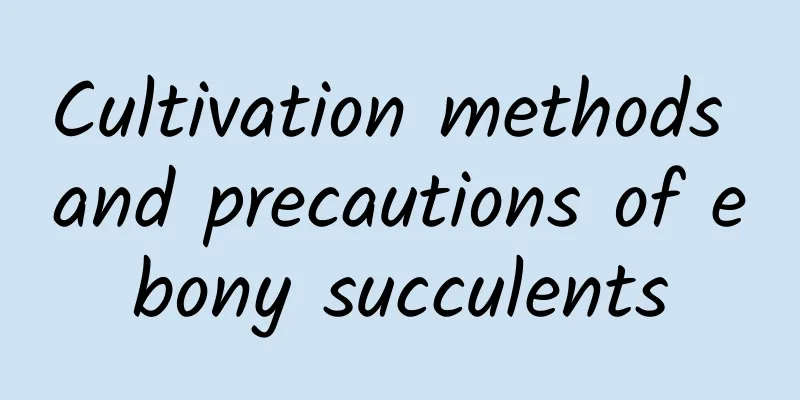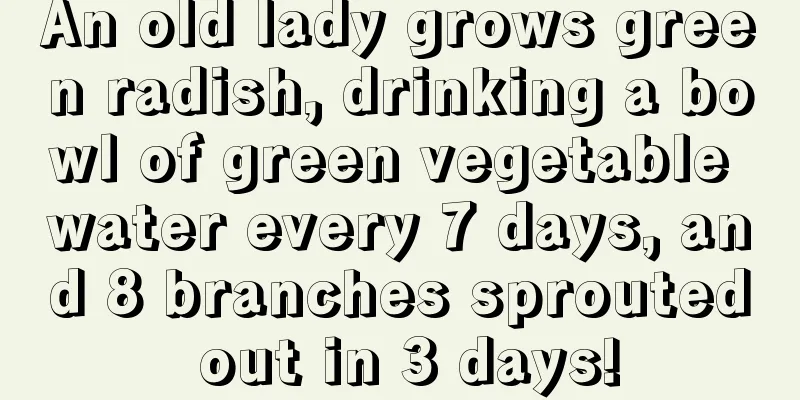Cultivation methods and precautions of ebony succulents

|
Ebony succulent is a relatively easy-to-grow succulent plant. Some people always say that it is easy to kill ebony succulent, mostly because they do not master the correct cultivation methods. Generally speaking, as long as the growth conditions in all aspects are suitable, it can be maintained in a relatively good state all year round, will not fade suddenly, and can withstand slightly higher temperatures. How to grow ebony succulents1. Soil Cultivating ebony succulents requires soil with good air permeability and water permeability, because its leaves themselves contain a lot of water. If water accumulates in the soil, root rot is likely to occur. Generally, peat soil, river sand and perlite can be mixed in a certain proportion and used. 2. Watering Ebony prefers a drier growing environment, so don't water it too frequently. During the peak growth period in spring and autumn, you can water it thoroughly after most of the soil is dry. In summer and winter, you must follow the principle of watering thoroughly when the soil is dry. 3. Temperature When its growth temperature exceeds 35 degrees, we need to provide it with appropriate shade and keep it in a well-ventilated environment. When the temperature drops below 5 degrees in winter, we need to move the ebony to an environment with a temperature above 10 degrees to avoid frostbite. 4. Fertilization Ebony is not a succulent that likes fertilizer. Generally, fertilization should be stopped during the slow growth period, otherwise it will easily cause the roots of ebony to burn. During the vigorous growth period in spring and autumn, it is enough to apply nitrogen, phosphorus and potassium triple fertilizer once every 20 to 30 days. Precautions for the maintenance of ebony succulents1. Shelter from the rain During the rainy summer months, ebony succulents are more afraid of being caught in the rain. After being caught in the rain, it is easy for their leaves to turn black and rot, and their roots and leaves to rot, so you must take measures to avoid the rain. 2. Ventilation The growth of ebony succulents should not be in a poorly ventilated environment, especially in a hot and humid environment. If the ventilation is not good, the ebony will definitely turn black and rot due to the humidity and heat. |
<<: Can passion fruit be propagated by cuttings?
>>: The pros and cons of the Chenonceau Rose
Recommend
How to deal with hyacinth after flowering
1. Hydroponic hyacinth After the hydroponic hyaci...
This flower is bigger than my face, one flower is worth 10 flowers, it’s so easy to make the pot burst!
The most beautiful moments of various dahlia vari...
Environmental conditions and characteristics of mangrove growth
Environmental conditions and requirements for man...
How to germinate mangosteen seeds and grow them into potted plants
Mangosteen Seed Germination Method Step 1 : Selec...
How to grow hydroponic daffodils correctly and how long does it take to bloom
1. Correct method of raising 1. Water source sele...
What to do if the lucky bamboo leaves are dry
1. Too much watering 1. Symptoms: If you give it ...
Blue bean cultivation methods and precautions
1. Maintenance methods 1. Substrate selection: Bl...
The efficacy and function of crystal palm
The garden value of crystal palm Crystal palm is ...
What to do if there are white spots on the leaves of rubber trees
1. Watering It is drought-resistant but not water...
Causes and treatments for yellowing leaves of moss phlox
1. Lack of water Reason: Shibazakura likes to gro...
When is the best time to plant nail grass seeds?
Nail grass seed planting time Nail grass is an an...
Durian pictures (introduction to morphological characteristics and maintenance methods)
1. Morphological characteristics 1. Leaves: The l...
How to keep bear paw in winter
1. Breeding methods in the north 1. Move indoors:...
Cultivation methods and precautions of Schefflera variegated
1. The habit of this plant (1) First of all, it l...
Where is the best place to plant August fried
August fried planting place August Explosion gene...









